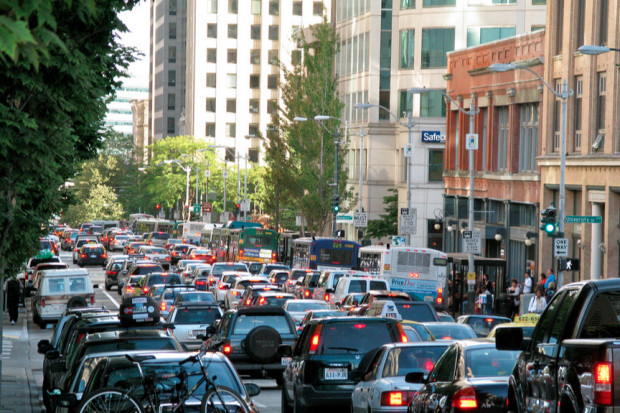
The concept of downtown tolling to reduce congestion is gaining momentum. Cities like Singapore and Stokholm have implemented congestion pricing and significantly increased transit ridership in their urban cores. New York City will become the first in the U.S. to launch a similar program.
Could Seattle be next? Uber and Lyft hope so.
The ride-hailing companies are throwing their weight behind congestion pricing as a way to create a level playing field among all drivers and avoid taxes specific to their business models. They see an opportunity in Seattle, where Mayor Jenny Durkan favors a congestion pricing system. To explore what downtown tolling would actually look like in Seattle, Uber commissioned a report from consultants at ECONorthwest.
The study, released Wednesday, estimates tolling could reduce travel times downtown by up to 30 percent during rush hour. The model explored approximates total gross revenue of congestion pricing would be at least $130 million per year.
Congestion pricing, a.k.a. tolls that drivers pay when they enter the most congested neighborhoods during the busiest times, was once seen as political poison in the U.S. but growing traffic across the country has cities considering it more seriously. Uber and ECONorthwest set out to determine the ideal fares for congestion pricing given Seattle’s current traffic reality.

The scenario explored in the report would charge drivers $1.50 to drive downtown midday and $3.80 during the afternoon commute. It would be free to drive between 11 p.m. and 5 a.m. The study relies on travel data from Uber and the Puget Sound Regional Council in its analysis.
“ECONorthwest approached the study of what a congestion pricing program might look like in Seattle by first asking the question: what kind of pricing would be needed to meaningfully reduce the number of cars on the road during peak commute times,” said ECONorthwest’s Matthew Kitchen, the primary author of the study.
One of the chief criticisms of congestion pricing is concern that it would hit low-income residents hardest. ECONorthwest accounts for that, suggesting a “Mobility Fairness Program” that would earmark $50 million of the annual revenue generated by congestion pricing as rebates for low- and middle-income families. The report estimates wealthy households would bear the biggest burden of the tolls because high-income earners account for most of the people driving downtown at peak times.
Still, advocates for congestion pricing face an uphill battle, as Durkan explained at an event in May.
“In the West, and particularly Washington state, there’s a real resistance to congestion pricing for a range of reasons,” Durkan said. She used Washington’s failed “block the box” legislation as an example. The bill would have authorized camera ticketing when cars block bike boxes, transit lanes, or wheelchair ramps. What lawmakers thought would be an easy win ultimately failed because “there was a lot of resistance to having camera enforcement.”
“It taught us a lot of lessons about who we need in the coalition,” Durkan said. She added that while there are different ways to implement urban tolling, “most of them use some kind of camera enforcement and automatic reader.”
